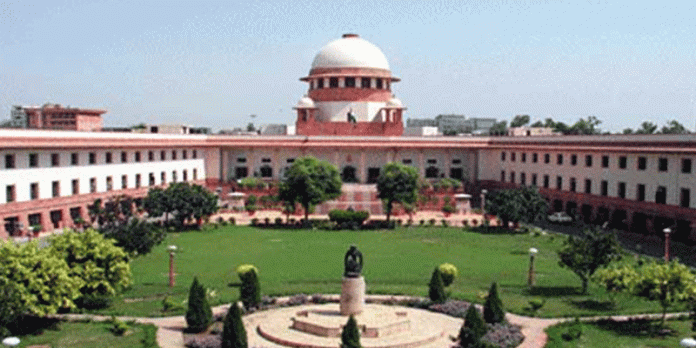In his book, Supreme Court Of India: The Beginnings ,the late George H. Gadbois, Jr. a retired professor of the University of Kentucky and an expert on the Indian judiciary, has listed ten events that can be seen as the most important ones in the evolution of India’s powerful Supreme Court.
- The first is Sir Hari Singh Gour’s resolution, introduced in 1921 during the first session of the Central Legislative Assembly, wherein he called for the establishment of an indigenous appellate tribunal.
His resolution was the first of the efforts made to convince the colonial authorities and Indian nationalist leaders, that a central judicial institution on Indian soil was needed.
According to Gour establishing such an institution would result in a court in India which would be empowered to decide civil and criminal appeals from the High Courts of British India, and see the reduction of appeals going directly from the High Courts to the Judicial Committee of the Privy Council in London.
However such efforts were met with failure for several years, primarily because key Indian leaders were not convinced that India’s interests would be served best by decreasing the role of the Privy Council, which over the years had earned a reputation for impartiality and integrity which placed it in a category apart from all other colonial institutions.
- In the opening session of the Indian Round Table Conference in 1930 in London, the spokesmen for the Indian States indicated their willingness to participate in a federation with the Provinces of British India. Leaders of both sides agreed that a Federal Court would be essential to interpret the constitution and settle disputes between the federated units.
In a compromise regarding its jurisdiction, the Government of India Act of 1935 made provision for a Federal Court without a general appellate jurisdiction, but which might at some future date take over the appellate jurisdiction of the Privy Council.
- The inauguration of the Federal Court in 1937 is the third major milestone, marking the setting up of India’s first central judicial institution. It comprised two judges and a Chief Justice, and was smaller than any of the Provincial High Courts. The court’s jurisdiction was very limited, and its decisions were subject to review by the Privy Council.
- Initially, the Federal Court’s impact was minimal with just twenty-seven decisions and two advisory opinions in the first four and half years. But in 1942 the Federal Court made several important rulings striking down provisions of the infamous sedition, preventive detention and special criminal court ordinances and legislation, or that the executive had failed to act within the limits of its authority.
Most of these decisions were unanimous, with the British Chief Justice joining in with his Indian colleagues. The decisions proved the resoluteness, impartiality and independence of the Federal Court.
- Although the achievement of independence did not affect the functioning of the Federal Court, two years later the Abolition of Privy Council Jurisdiction Act was passed which severed all ties with the Privy Council. More psychological in nature , the move eliminated the feeling that the Federal Court was an intermediate appellate tribunal.
- The sixth event of great significance was the replacement of the Federal Court by the Supreme Court in 1950 when the Constitution of India became operative.
The jurisdiction and powers of the Supreme Court was however much different from that of its predecessor. The Supreme Court was placed in a position of central importance empowered with an extraordinarily wide jurisdiction, and authorized to exercise the power of judicial review.
- The Supreme Court ruling in the case of K. Gopalan v. The State of Madras is the seventh milestone. This case had a lot of firsts
- The first case wherein the Supreme Court had to interpret the new Constitution,
- The first involving the fundamental rights,
- The first to involve the controversial Preventive Detention Act,
- The first in which an individual took his grievance directly to the Supreme Court, bypassing all lower courts
- The first in which the Supreme Court, in the exercise of its new powers, declared unconstitutional a portion of a Parliamentary enactment.
- The eight import important development was the Supreme Court ruling in the Dorairajan case in in 1951.
It is considered as one of the most important judgement to be given by the Supreme Court, as it was the first case to involve the fundamental rights as well as the directive principles.
The Court in its decision enforced the fundamental right over the directive principle, and described the fundamental rights as “sacrosanct” and the directive principles as “subsidiary”.
- The enactment of the Constitution (Fourth Amendment) Act in 1955 is the next most important milestone. As a result of several Supreme Court decisions regarding the protection of property rights by the Constitution, the Fourth Amendment sought to limit the Court’s review powers in regards to restriction and acquisition of property rights.
- The final development of significance is the Supreme Court’s shift toward a more liberal interpretation of the Constitution. The Court has discussed in its various rulings the social and economic policy considerations which are either explicit or implicit in the Constitution and various enactments, and going as far as to endorsing the directive principles as worthy goals.
A Worthy Predecessor
In comparison with the Supreme Court, the Federal Court was small in size, limited in jurisdiction, and functioned during the tumultuous twilight of the British raj making it an institution of peripheral importance.
However it was a stable and respected institution which functioned according to the terms of its charter at an critical period in modern India’s history . Despite its severe handicaps, it was independent of the executive. It was able to demonstrate all the qualities—independence, impartiality, integrity, and dignity—that Indians associated with the Privy Council, and which they wished to for the judiciary in India to emulate.





